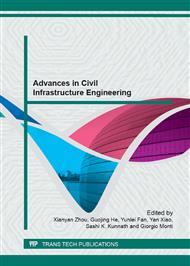p.992
p.998
p.1003
p.1010
p.1015
p.1021
p.1025
p.1029
p.1033
S7-13 Detecting Voids in Tendon Ducts of Post-Tensioned Bridge Girders
Abstract:
The tendon ducts in post-tensioned bridge girders must be grouted fully so as to prevent water and oil stain from entering the ducts, which will decrease the durability and load-carrying capacity of post-tensioned bridges badly. This paper describes the motivations for and recent history of Impact-Echo (IE) scanning applications to internal grout condition evaluation of tendon ducts in post-tensioned girders. The tendon ducts’ internal injection quality of a railway bridge in Yichang city was evaluated using IE technology. During the in-situ testing, the IE signals were collected firstly, then the transformation from the time to the frequency domain was carried out using the principles of the fast Fourier transform, data interpretation was much simpler and quicker in the frequency domain. The grout condition of tendon ducts could be determined according to the frequency analysis, poorly grouted sections can be differentiated from the well-grouted sections within the tendon ducts. Results show that the IE method can be employed to detect voids in the grouted tendon ducts of many types of post-tensioned structures.
Info:
Periodical:
Pages:
1015-1020
Citation:
Online since:
January 2013
Authors:
Keywords:
Price:
Сopyright:
© 2013 Trans Tech Publications Ltd. All Rights Reserved
Share:
Citation:


